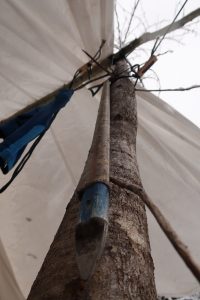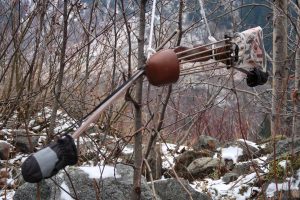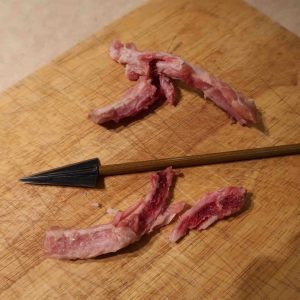In 2003 I came to the Rockies with a dream of sheep hunting burning in my soul. My gear was typical of a Western European forest tree stand hunter. Heavy boots, thick sweaters and jackets, a 9 ½ pound rifle. I quickly bought a hefty sleeping bag, a foam mat, a $150 backpack, a billy pot, a diminutive propane burner, and I was off to the mountains.
Ignoring for a moment that first year when I had to learn the hard way that a little hill in the Belgium Ardennes was poor preparation for the East Slopes of the Rockies, that gear was pretty much all I needed to survive. Cotton clothing, army surplus for the most part, must have kept me wet and cold sitting on a high ridge after a big climb, but heck, I was sheep hunting! My day pack contained some raingear, salami, cheese, nuts and Snicker bars for lunch, knife, moleskin and tape to deal with the blisters. Map and compass too, I reckon. An overnight pack had the big heavy sleeping bag, foamy, tarp (not the fancy kind) and the cooking gear. My most expensive piece of gear was my binoculars, a pair of Swarovski SLC 10×42.
I have lost many photos of those first few years unfortunately, but I managed to recover a few low-res images from forgotten sources. Here are two examples of frugal camps. I was tougher than I was smart, and “hunting” consisted mostly of long hard treks, with the odd half hour of glassing thrown in here and there. I wish someone back then had steered all that energy in the right direction, but I hunted mostly solo and had to make all the mistakes myself; many times over.
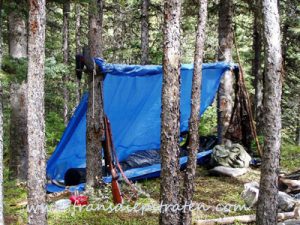
My first sheep camp. Pretty nifty set up until the snow started flying
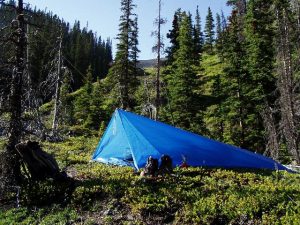
Scouting for sheep, surrounded by promising basins. Mice chewed the fingers out of my deerskin gloves that night
Fast forward 14 years. Looking over all the gear I took mountain goat hunting, scattered across my basement room, I can’t help but wonder what Fred or Jack would have said, had they been able to see my collection of stuff and gadgets.
Over the years I improved many components to my “kit”. The first to go was the tarp. A lightweight one-person tent provided a bit more shelter, later replaced by a two-person because the one-person was a bit tight and claustrophobic, and I needed room to keep the dog and gear out of the rain (never had that problem with a tarp).
I probably spent several times more on that set of lightweight rain gear than the worth of all my old clothing put together. It replaced a heavier set of big-name-retail rain gear that had the unhappy habit of sucking water into the cuffs and transferring that to the liner, causing me to be wet from the elbows and knees down.
The Exped 7 Downmat was a life saver. An aging back no longer enjoyed a half-inch thick foamy, so for probably 25 times the cost, I bought comfort. Of course the heavy sleeping bag had not been a smart purchase, and it was replaced by a much lighter, and more compressible down bag. Through winning a Rokslide (www.rokslide.com) push-up contest (old-man category) I added another bag, a synthetic minus-something bag for the really cold days (and most my days are really cold, as I seem to be one of those guys that can’t seem to stay warm at night).
After years of enduring the agony of a cheap backpack, I finally broke out the checkbook and bought what was probably the last Kifaru Timberline before they went to the detachable frame. A daypack was added through winning a photo contest (I get lucky sometimes, I also won a Sitka Kelvin jacket through an instagram photo contest).
Then came 2013, and a coveted late season draw tag for bighorn sheep. Now I really started piling on the gear, from merino base layers, to expensive insulated pants, gloves, pac boots, and much more in order to be ready to fight the -30 temperatures and gale-force winds.
Of course there was a new lightweight rifle, because no sheephunter should carry a 9 ½ lb set up; a new bow after the sight on my old hand-me-down finally broke; a satellite messenger for the home front, and then another one that allows sending texts, and battery packs to keep those and the paired cell phone powered up, a folding knife with replaceable scalpel blades, too many fixed-blade knives (I have a problem), fancy high-speed water boiler, better this, more of that. There is no end.
I know there is no going back on some things. The comfort of a good sleeping pad I will not forego. Some clothing is so much better than the stuff I had fifteen years ago, that I can’t see myself going back to cotton t-shirts and jeans. I knew the very moment that I purchased a SPOT messenger that that genie would never go back into the bottle. I get daily crap from my family for not taking my cell phone when I walk the dogs and stay out longer than expected. Not taking the Inreach on multi-day trips would rank up there with the other mortal sins.
Recently I have been taken my old billy pot out for hikes again. Despite washing it, the pungent smell of the many campfires never quite comes off, like it is fused into the metal. It holds a little bit of each of those early mountain hunts, when I was low on experience, but high on enthusiasm, and energy was in unlimited supply. I think I will go have a good hard look at my gear, and figure out how I can simplify it a bit.
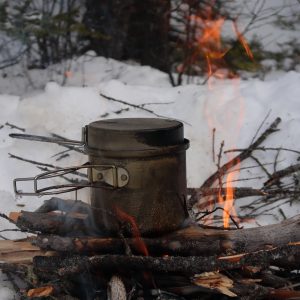
A campfire and an old billy pot – nostalgia over efficiency and speed
That foldable scalpel blade, I think I will start with that one. It’s not a real knife anyway. Besides, I just got a fancy custom knife that looks better with the new longbow.
What is your one piece of gear that you won’t go without? And what might you leave at home this year?
